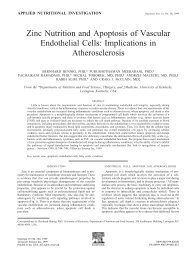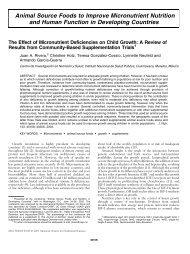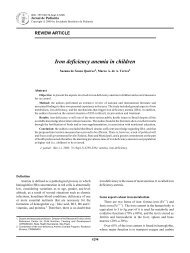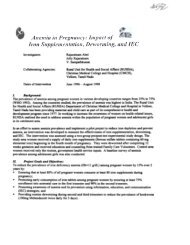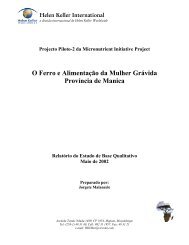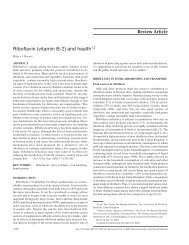Micronutrient Interactions: Impact on Child Health and ... - Idpas.org
Micronutrient Interactions: Impact on Child Health and ... - Idpas.org
Micronutrient Interactions: Impact on Child Health and ... - Idpas.org
Create successful ePaper yourself
Turn your PDF publications into a flip-book with our unique Google optimized e-Paper software.
Ir<strong>on</strong>–ascerbic Acid <strong>and</strong> Ir<strong>on</strong>–calcium <str<strong>on</strong>g>Interacti<strong>on</strong>s</str<strong>on</strong>g> <strong>and</strong> Their Relevance in Complementary Feeding<br />
Ir<strong>on</strong>-calcium <str<strong>on</strong>g>Interacti<strong>on</strong>s</str<strong>on</strong>g><br />
An inhibitory effect of calcium <strong>on</strong> ir<strong>on</strong> absorpti<strong>on</strong><br />
was recognized nearly 60 years ago.<br />
In the past 10–15 years many investigators<br />
have focused <strong>on</strong> this issue, trying to define<br />
the practical importance of the interacti<strong>on</strong><br />
<strong>and</strong> the mechanism by which it occurs. The<br />
results of these studies are often c<strong>on</strong>flicting<br />
because several factors influence the interacti<strong>on</strong><br />
between calcium <strong>and</strong> ir<strong>on</strong> absorpti<strong>on</strong>,<br />
including the molar ratio of calcium<br />
to ir<strong>on</strong>, the forms of calcium <strong>and</strong> ir<strong>on</strong>,<br />
whether these minerals are c<strong>on</strong>sumed in the<br />
presence of food, <strong>and</strong> the ir<strong>on</strong> status of the<br />
subjects.<br />
The mechanism by which calcium impairs<br />
ir<strong>on</strong> absorpti<strong>on</strong> remains c<strong>on</strong>troversial<br />
(Hallberg et al. 1992a). It probably does<br />
not involve reducti<strong>on</strong> of intestinal pH or<br />
the formati<strong>on</strong> of insoluble ir<strong>on</strong> salts such as<br />
carb<strong>on</strong>ates. It is not clear whether calcium<br />
competes for low-molecular-weight lig<strong>and</strong>s<br />
that enhance ir<strong>on</strong> absorpti<strong>on</strong>. Calcium<br />
equally inhibits the absorpti<strong>on</strong> of n<strong>on</strong>heme<br />
<strong>and</strong> heme ir<strong>on</strong> (Hallberg et al. 1991), which<br />
enter the mucosal cell by different pathways<br />
<strong>and</strong> leave in the same form, suggesting that<br />
calcium inhibits the intracellular transport<br />
of ir<strong>on</strong> (Hallberg et al. 1992b). Calcium may<br />
compete for ir<strong>on</strong>-binding sites in<br />
mobilferrin, a protein in the duodenal mucosa<br />
that may assist ir<strong>on</strong> transport through<br />
the cell (C<strong>on</strong>rad <strong>and</strong> Umbreit 1993).<br />
Mobilferrin can bind calcium although it<br />
has a greater affinity for ir<strong>on</strong>. Calcium may<br />
also inhibit the release of ir<strong>on</strong> from mucosal<br />
cells into the circulati<strong>on</strong> (Wienk et al. 1996).<br />
The inhibitory effect of calcium <strong>on</strong> ir<strong>on</strong><br />
absorpti<strong>on</strong> is independent of the amount of<br />
phytate in a meal (Hallberg et al. 1992b)<br />
<strong>and</strong> does not interfere with the enhancing<br />
effect of meat (Hallberg et al. 1992b) or<br />
ascorbic acid (Hallberg et al. 1992a). It is<br />
important to recognize that adding calcium<br />
to wheat flour before leavening causes a further<br />
substantial decrease in ir<strong>on</strong> absorpti<strong>on</strong><br />
because calcium inhibits phytase activity in<br />
yeast (Hallberg et al. 1991). As little as 40<br />
mg calcium added to 80 g flour inhibited<br />
phytate degradati<strong>on</strong> during leavening by<br />
50%. This means that calcium fortificati<strong>on</strong><br />
of wheat flour may reduce the beneficial effects<br />
of fermentati<strong>on</strong> <strong>on</strong> the bioavailability<br />
of ir<strong>on</strong> <strong>and</strong> other minerals bound to phytate.<br />
Amount of Calcium<br />
Hallberg et al. (1991) added between 40 <strong>and</strong><br />
600 mg of calcium, as calcium chloride or<br />
dairy products, to wheat rolls c<strong>on</strong>taining<br />
3.8 mg ir<strong>on</strong>. Ir<strong>on</strong> absorpti<strong>on</strong> fell relatively<br />
linearly to about 40% at 300–600 mg calcium.<br />
There was no effect of adding 40 mg<br />
calcium (calcium-ir<strong>on</strong> molar ratio 14:1),<br />
<strong>and</strong> at the upper end adding 600 mg rather<br />
than 300 mg had relatively little additi<strong>on</strong>al<br />
inhibitory effect. However, it is not <strong>on</strong>ly the<br />
calcium-ir<strong>on</strong> molar ratio that is important,<br />
because there was no effect of adding 3 mg<br />
calcium <strong>on</strong> the absorpti<strong>on</strong> of a trace amount<br />
(0.01 mg) of ir<strong>on</strong>, a calcium-ir<strong>on</strong> molar ratio<br />
of 420:1 (Hallberg et al. 1992a).<br />
Form of Calcium<br />
The form of calcium also influences its inhibitory<br />
effect <strong>on</strong> ir<strong>on</strong> absorpti<strong>on</strong>. A review<br />
by Whiting (1995) revealed that 500–600 mg<br />
calcium added to meals typically reduced<br />
ir<strong>on</strong> absorpti<strong>on</strong> by about 40% when added<br />
as cheese <strong>and</strong> milk; 40–50% when added as<br />
calcium phosphate, carb<strong>on</strong>ate, or hydroxyapatite;<br />
<strong>and</strong> 60–70% when added as<br />
more soluble calcium citrate <strong>and</strong> calcium<br />
citrate malate supplements (Hallberg et al.<br />
1992b, Cook et al. 1991b, Deehr et al. 1990,<br />
Daws<strong>on</strong>-Hughes et al. 1986). Calcium carb<strong>on</strong>ate<br />
had no effect <strong>on</strong> ir<strong>on</strong> absorpti<strong>on</strong> in<br />
at least <strong>on</strong>e report (Seligman et al. 1983).<br />
Although these observati<strong>on</strong>s may indicate<br />
that more soluble forms of calcium have a<br />
greater effect <strong>on</strong> ir<strong>on</strong> absorpti<strong>on</strong> because the<br />
inhibiti<strong>on</strong> occurs within the mucosal cell,<br />
15




